
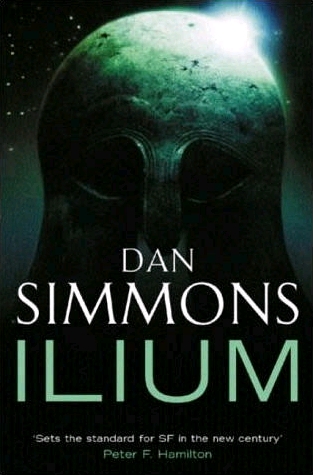
I have to be honest and say that even though I knew a little about the Trojan war; some history lesson that I would have been thought as a ten year old boy, I never would have believed it possible for a science fiction novel to smack the dust from my memories and instil a sense of wonder in me that Homer's Iliad would have struggled to emulate. Where do I start? Surreal in its conception, though based on the mythical recounts of the siege of Troy, set over three thousand years in the past - Ilium is a retelling of that ten year long war which brought forward the names of such mythical heroes of Hector, Achilles, Paris, Odysseus et al from some of the earliest years of western civilization. Lost in time, Thomas Hockenberry, a reanimated mortal being who possesses some faded memories of his past life is a scholic who witnesses the day to day drudgery and bloodshed of the Trojan war. He is an observer who under the petulant presence of his Muse and the Gods of Olympos is able to blend in seamlessly with both the besieging Greeks and the besieged Trojan's via technological devices left at his disposal. He has seen enough and even though he taught about this period of history in his past life he tells us jadedly that "I...no...longer...give...a...shit." The ancient Greek gods play favourites with their chosen warriors and in return these favoured beings are protected and battle enhanced through nanotechologies. The events of these super beings whose home on the extinct volcano of Olympos Mons on Mars bring them to the notice of moravecs. The gods are with their strange technologies creating quantum fluctuation which worry the beings surrounding the gas giant Jupiter. A mission is sent to the once red planet, now a terraformed blue planet. This missions goal is shrouded in a cloak of mystery which the two moravecs, Mahnmut of Europa and Orphu of Io are not privy to. On earth the population is at an almost unbelievable one million inhabitants and the people live in a utopia. The population demographic is steady - constantly steady and people travel and live a carefree existence under the protection and servitude of Voynix and servitors. Does paradise truly exist? For the illiterate population it does. Simmons accounts how that once a person reaches the age of one hundred or as it is referred to - their fifth twenty, their physical life on Earth ends and via certain faxnodes they are whisked away to a orbital ring where they believe they will live forever. On this eerily familiar yet alien planet of ours we are introduced to human beings who live not knowing anything about art, history, culture, language or even the forgotten technological toys at their disposal. Is is only when a quartet of these eloi meet the woman Savi that their ignorance is exposed to them. From the open page to the final sentence this novel had me hooked. From the high brow conversations exchanged between Mahnmut with his love for Shakespeare (especially the sonnets) to Orphu's love of Proust, we are treated to something very special. From Thomas Hockenberry's close shave with death and the wrath of the gods to the carnage depicted on the battlefields this novel doesn't simply sizzle with space opera intelligence, it burns with an incandescent flame. This book builds and builds and builds to a wonderful finish without ever lessening in its intensity and sheer wit. Simmons is the only author I know who has ever used the line "And blah and blah and blah." When you read in its context you will understand just how wonderful his prose truly is. This is essential reading. An unputdownable novel.

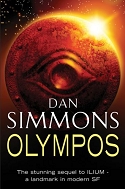
As soon as I completed reading Ilium I immediately realized that I had to go out and buy Olympos - which I duly did the day after finishing Ilium. If you considered Ilium complex then reading Olympos will not come as a shock. The god of Olympos are at war, the battling Greeks and Trojans end their battles, become allies, then enemies once again. Achilles - the god slayer is a on a quest to eradicate those foolish enough to cross him and this is but one fragment of the many strands that are interwoven into Olympos. Although a much slower paced novel than Ilium, Olympos allows the characters of the moravecs, gods, moravecs and avatar entities of such beings as Prospero, Ariel and the endangered post-humans air to breathe and develop. Setebos, that brain shaped malevolence is loose on the post human earth, the vyconix are terminating with extreme prejudice all human beings they encounter and the calibani have begun to migrate free from the dry Mediterranean basin. The faith of humanity, post humanity, is looking grim. Can the enigmatic Greek hero Odysseus somehow save Ada, Harmann, Daemon and all those surrounded by the killing machines which surround the redoubt that is now Ardis Hall? The technology which once served the likes of Ada and Harmann and the small population of Earth is now killing without any logical reason and the faxnodes are now inoperative. Simmons seems to leave the denizens of Earth with no recourse but with such a novel as Olympos, the sum of all fears does not mean their realizations. Simmons teases us with suspension, terror, and fear which ominously threatens all life on the Ilium Earth and the Earth of the post-humans. He draws out events with a panache that at times seems to wallow in way too much wordplay but is in fact a very cunning and masterfully told novel. The moravecs are kept very busy in this novel as they will play pivotal roles in the success or failure of the survival of the species. Heroes, gods, machines, post-humans, and even history itself will all pay a heavy toll before this novel finishes. What a wonderful novel this was to read. I cannot recommend it highly enough.

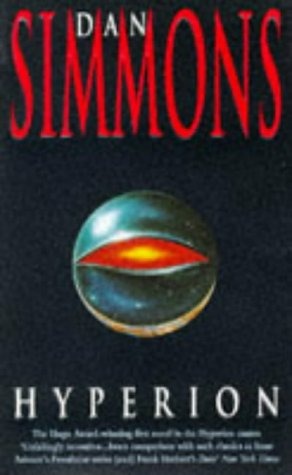
Hyperion; a planet which may hold the key to the possible future or destruction of all humanity, sets the scene for a powerfully poignant and harrowing set of tales. It is the twenty ninth century and with Old Earth now a lost home, a planet devoured by a singularity many centuries past, we are introduced to the web of human connectivity and space that is ruled by the Hegemony. This novel reads more like a series of seven loosely inter connected novellas in which seven unwilling pilgrims participate in retelling how it is that he, or she, managed to end up on the planet Hyperion. Their independent yet shared journey to visit the legendary Time Tombs and to seek consul with the a dreaded new age bogeyman named the Shrike allows them the comfort to drop their guards and reveal all to six strangers with whom they may be spending their final days. Through these recounts we are introduced to a time and place where the atypical wonders prevalent in science fiction reign supreme. However, this novel is not about the technology, it is about the unfortunate pilgrims' pain, need for closure, possible salvation, revenge, altruism and sheer desperation that encapsulates the human condition that uplifts this story. The priest's tale, the one that is told at the beginning, is a deeply upsetting recounting of a man disinherited for his means not justifying his very untimely end. It is the most chilling of all the stories to be retold by the seven. The war hero Colonel Fedmahn Kassad's tale is of a man rising from his humble origins who encounters a love that transcends the human experience. It is erotic and graphic but pales in contrast to the other stories. The poet's tale is very strange and incorporates the longest timeline and a character belonging to planet Hyperion's past. A tremendous amount of understanding as to why Martin Silenus is the way he is imparted to the reader and I found his tale to be delivered with a tremendous restrained panache and flair. Juxtapose this to the irascible drunk and genius poet that he actually is leaves one with the impression that it is acceptable to have various conflicting feelings about a tortured soul. The fourth story is a real tear jerker involving a Sol Weintraub and his baby daughter, Rachel. One cannot help but feel a tremendous empathy for the unfortunate pair. It is wonderfully written and told with a passion and sense of sheer frustration that really makes you stop and think. Detective Brawne Lawmia’s recounting of how she ended up with this party is an interesting tale with a very bitter sweet sting. Finally, we come to the novel's mysterious, unfussy and central character - The Consul. His story is different from the others in that his reasons for being on the planet are very selfish, destructive and self centred. Overall, this was a wonderfully immersive book in which I lost many hours. This book does not come to any conclusion, one would definitely need to go out and read the Fall Of Hyperion to find out what faith befalls the seven. The sense of being there, reliving each character's past, understanding their motives, having the jigsaw pieces of the various elements of the Hegemony explained, and brought to life was a pleasurable learning experience. Hawking drives, "Sad King Billy", fatlines, farcasters, indigenous populations, malevolent AI's, time dilations and so much more await you within the five hundred pages of this 1990 Hugo Award winner.


The Fall Of Hyperion, naturally, as one would expect, continues from where the excellent Hyperion finished. The Time Tombs are opening, the dreaded attacks from the feared offshoot of humanity - the Ousters - are encircling the worlds of the Hegemony, and the obfuscated AI's of the Technocore are all brought into focus. This novel and its subsequent plot is analogous to the skin layers of an onion being peeled; the more layers that are revealed, the more the centuries' long duplicity, paranoia, and strategic wranglings are revealed. The Hegemony is given more page space in this novel with the forlorn figure of Meina Gladstone, CEO of over one hundred billion, playing a very dangerous game with the political, ethical, moral and physical wellbeing of this altruistic empires denizens'. The band of seven pilgrims all encounter the Shrike in one on one encounters and are helpless to this abomination's will. The Shrike is never satisfyingly explained in this novel, it is only through the ramblings and double talk jibber jabber of the AI persona Ummon that we learn of the reason for Hyperion's great worth and essentialness to the wellbeing or destruction of all of humanity. This revelation was one of the high points of the novel, it is so deliciously exposed and postulated as both lie and truth that are the hallmarks of AI's made gods by human ignorance. Simmon's love of convoluted yet coherent plot twists concerning the dilemmas that each of the pilgrims faces; one which challenges each of them with his or her own greatest fears, was told with a restrained, dramatic flair, one which exposes new, and sometime even frightening psychological terrors. This is a frenetically charged novel with the need for chopping from one character or characters on one planet, to another on yet another planet, maintaining a heightened sense of immediate danger and the need for resolution, any type of resolution, to make itself known. This book was a complete joy to read but at times I felt there were a few passages which, if omitted, would have allowed a more seamless and less poetic rhythm to the book. A brilliant follow up!


Set some three hundred hundred years after the events in the previous two novels of this four novel saga, Endymion reintroduces us to some very familiar and not so familiar characters and places. A young man named Raul Endymion is saved from death by the legendary Martin Silenus and offered the once in a lifetime opportunity to become a hero. All he has to do is save a young girl named Aenea, when she emerges from the time tombs on Hyperion, from the ubiquitous and all powerful Pax. Doesn't sound hard does it? Naturally, he accepts. Then events get very interesting. It is the year 3126 and since the galaxy changing events that have followed since the Fall, humanity has seemingly found salvation with the Church. This church and its religion is Roman Catholic but it offers something that no other religion has never been able to - true immortality via the cruciform. Shaped like a cross this biological reanimation machine brings back people from the dead. The church naturally controls all those who receive this most sacred of sacraments. Raul does not have one, nor does he wish to receive the cruciform. The church's military arm known as the Pax await Aenea's reemergence. Overseeing this child's return is one priest captain called Father de Soya. A man possessed with high morals and racked with some inchoate unease at this young girl's arrival he is under the auspices of the church to bring her back unharmed. Foretold by the many different background characters such as entity from the TechnoCore, and the now ancient poet Martin Silenus, this girl is either a virus sent to wipe out all the church's good work or a true messiah. After rescuing her from the Pax with the help of the Hawking mat and the psychotic slaughtering of the Pax by the Shrike Raul and Aenea are forever on the run from those who wish them harm. This novel is a work of triumph. It has no flaws. Deep and intricately woven is the plotline that seemingly innocuous events, far reaching plans, and unexplainable reasons as to why elements of dangerous and surreptitious agents help the church to capture just one child lead us to question why they do what they do. Somebody is being lied to. This rip roaring space opera infused with a quirky sense of humour, peopled with beings that remain all too human despite their new found immortality, worlds and future histories brought to life, is in my eyes, a wonder of human creativity. Thoroughly recommended!

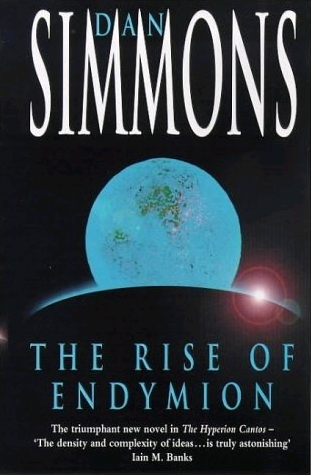
Synopsis
The final chapter of this saga begins with two momentous events: the death and resurrection
of Pope Julius XV and the coming-of-age of the new messiah, Aenea. Together with
her protector, Endymion, she embarks on a final mission to find and comprehend the
underlying fabric of the universe.This novel concludes the Hyperion Cantos with aplomb. Raul and Aenea, seemingly inseparable, have been living on a commune on the kidnapped Earth for over four years. Life is good to them. But such events cannot be allowed to last - all good things come to end. Raul is advised by Aenea that he must undertake a quest of his own. From these events this novel very quickly accelerates into a full blown odyssey. Aenea is the answer, has the answers, to so many questions left unanswered in the previous novel that it left this reader wondering if Simmons' could keep the plot from descending into a miasma of technologies threatening to consume all of humanity. He succeeded! The Pax with its terrible archangel class of ships with near instantaneous travel gives the church an almost unbelievable advantage in space, the genocide committed in the name of good related is a horror of near untold imagining. However, the reader is in no way left with the feeling that space is the only battle scene within the seven hundred and fifty six pages. Our very minds and the way we control our own destiny is slowly revealed. The TechnoCore with its bogeymen/killing machines has one plan - to enslave humankind. The old adage that manipulating the masses without them knowing they are being manipulated is wonderfully expounded by these creatures. Religious leanings combined with our ego driven needs to attain a immortality is wonderfully recounted by an artificial intelligence enslaving an almost willing - too willing - is some of the most mellifluous story telling I've ever been enthralled to read. We are made aware that Raul retells his account of what has happened, what is happening, with a strangely disconnected and interred voice sealed inside a high tech cell: a Schrödinger's box. The novel falls downs slightly in that there are certain passages, especially in part two of this novel, where the storytelling and plot goes off at tangents that do not enrich the plot or give more depth to the characters. One particular scene has Raul managing to defeat the AI construct Rhadamnath Nemes in one on one combat. It was truly an irksome plot development. The untold depth of preparation that it took to create these novels bears all the hallmarks of a master story teller at his peak. Comes close to being perfect.

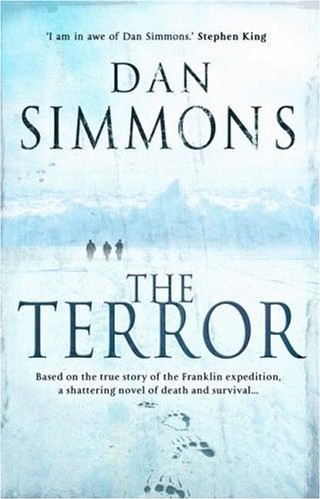
The year is 1845 and the ambitious nature of a foolhardy captain is to have bloody repercussions. The fabled North West Passage is yet to be discovered and the prize for being the captain of such a monuments voyage is bequeathed to the near sixty year old Sir John Franklin. Plans are made, all under this pompous blowhard's stewardship. In order to raise the likelihood of success a second ship of the Royal Navy, The Terror, captained by the stoic Irishman, Captain Crozier, is to accompany Sir John Franklin's ship, Erebus.
So far so good. However the cold of an unusually early and severe three year deep freeze awaits the unfortunate crew of these two vessels. Both ships end up being trapped in the ice, hundreds of miles north from anything else other than snow and ice. Here is the early hook of the novel: we knew they are being some preyed upon by some monster on the ice. Sir John and various other members of both crews are dead, victim of this Arctic beast. It also appears that the best laid plans of this already doomed expedition have been spoiled. Here is where the other aspects of the dismal plight of these sailors' is is given a deeply unfair and faith-be-damned twist. The food provisions and coal supplies which were meant to last three years minimum are placed under duress; the coal consumption rises to keep the ships warm and over half the food, thanks to underhanded methods of procurement and poor soldering techniques, renders the majority of it inedible.
Two years after being trapped in the ice the command to abandon both ships is given. Moral is at an all time low, and the chance of being rescued is nil. Added to this the mutinous grumblings of some ne'erdowells creates headaches and political schisms for the beleaguered crew and its officers. They are also all very much aware of how vulnerable they all will be while the attempt to traverse the unforgiving desert. The tone of this novel is bleak, near hopeless, and heavily weighed down with a pervasive malaise. The cold can't be fought, the creature hunting them can't be killed, all circumstances are beyond their control.
But I found this to be a boring novel; well written, but boring. Everything seemed to be in place for a slow paced horror/fantasy adventure; one which should have given a wonderful glimpse into how like onboard a nineteenth century ship trapped in the Arctic waters for over two years should be portrayed. However, only two real characters brought any real empathic feelings to my mind. There was no real sense of urgency conveyed in the novel as being helplessly trapped in ice somewhat limits the sense of wonder needed to stop the storyline from descending into banality. Too often I found myself reading chapters which made me question the actual the actual language used by the officers and seamen, sometimes it just felt anachronistic. The Esquimax woman, Lady Silence, is this refugee onboard The Terror. She is meant to add some mysticism. I found myself never quite appreciating what it is she was meant to represent. The actual ending to the novel has a dreamlike quality rooted respect and understanding for the human/animal condition which did not resonate with me. Overall, I would have to admit that maybe, just maybe, I was looking for something a bit more flesh and bone, a storyline more readily accessible in its delivery, and evenly conclusive in its final rendition. At over 750 pages this novel is more deep freeze filler than deep freeze chiller.

| Authors | Awards | Blogs |
| Fanzines | Index | Magazines |
| Publishers | Retailers | Reviews |